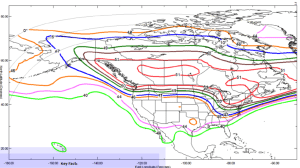Latest News
[Via Satellite 12-09-2014] Hunter Communications, a satellite communications provider in Canada, is readying for the launch of its first hosted payload on the Eutelsat 115 West B satellite early next year. The company, which provides satellite capacity from the “Big Four” and the majority of regional operators, has been operating over North America on Satmex 5 (later renamed Eutelsat 115 West A) as one of the spacecraft’s original clients for several years. As it neared the end of its life expectancy, Satmex shifted the satellite into an inclined orbit approximately a year and a half ago. Hunter Communications has carved a niche in the Canadian market through the inclined satellite, and is preparing for a push into mobility with its high-power Ku-band hosted payload next year.
“Canada is a bit of a unique market. There is certainly less demand for traditional Ku-band data services in comparison to the U.S. — because the U.S. has about 10 times the population,” Brent Perrott, president of Hunter Communications told Via Satellite. “The supply is just that limited in Canada and has been for so long that our small payload is probably coming at an opportune time.”
The hosted payload will provide Ku-band capacity over the United States and Canada with a footprint that is tweaked from the original Satmex beam. Perrott said the power and focal point of the beam is much further north than other satellites today, providing capacity over the Northwest Passage trade route as it opens. The hosted payload’s coverage also highlights Alaska and the Aleutian Islands.
“We really wanted to cover the maritime market on that West Coast. Cruise ships ply up and down the Inside Passage on the West Coast of British Columbia,” said Perrott. “We have a lot of fishing and shipping vessels around the Aleutian Islands, and over to the Pacific for more shipping.”
Perrott added that Hunter Communications is also planning a greater emphasis on In-Flight Connectivity (IFC) for aircraft transiting through Canada.
“Internet on commercial aircraft is going to soon become a norm and a requirement, and so for any airline traffic going transpacific or transatlantic, many of those planes are flying quite far north in Canada and Alaska. Having an entire beam with concentrated northern coverage is important,” he said.
Hunter Communications has worked with Panasonic Avionics in the past, whose eXConnect platform is based on Ku band. Perrott said the company is in discussions with Panasonic Avionics on using the hosted payload’s capacity.
Another benefit of having the dedicated hosted payload on Eutelsat 115 West B is that the spacecraft’s orbital position has four degrees of spacing between the next satellite with Canadian coverage. Perrott said adjacent satellite constraints made it difficult to place a traditional Ku-band beam over Canada on the Satmex 6 or Satmex 8 satellites. He expressed optimism that the strength of the beam would make the payload well suited for mobility.
“[There are] a lot of technical advantages when you are four degrees away from your nearest neighbor,” he said. “In terms of being able to use more power, that advantages smaller antennas — the sub one-meter antennas — so for anything aeronautical, or land-mobile antennas of 60 cm, it is a particular advantage that translates into lower operating costs on the satellite.”
Get the latest Via Satellite news!
Subscribe Now